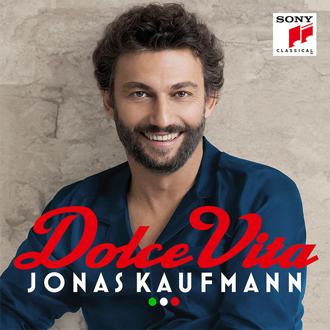 It
is hardly surprising with Christmas on the way that the world’s
premier tenor should release a crowd-pleasing album bursting
with winter sunshine. The Vespa-blue themed digipackaging is
handsomely produced with the full Italian texts translated into
three languages, far too many brooding photographs of our
dreamy, handsome, photogenic singer and an inside spread of the
Trevi Fountain to put us in the mood for an anthology of
favourite Italian songs dating back to 1881 (Gastaldon’s “Musica
proibita”), through the great era of Neapolitan ballads to
crossover hits of the post-war decades up to “Il canto”, written
for Pavarotti in 2003. For good measure, we have - in German,
and English and French but, interestingly and ironically, not in
Italian - a thoroughly irritating and self-consciously jokey
essay, which is short on actual information and very long on
whimsy, by one “Bodo Rossi”, which looks suspiciously like a
pseudonym to me – although I am open to correction on that one.
The author never spoke a truer word than when he concludes his
notes with the sentence, “And I’m already in irritatingly high
spirits.” It
is hardly surprising with Christmas on the way that the world’s
premier tenor should release a crowd-pleasing album bursting
with winter sunshine. The Vespa-blue themed digipackaging is
handsomely produced with the full Italian texts translated into
three languages, far too many brooding photographs of our
dreamy, handsome, photogenic singer and an inside spread of the
Trevi Fountain to put us in the mood for an anthology of
favourite Italian songs dating back to 1881 (Gastaldon’s “Musica
proibita”), through the great era of Neapolitan ballads to
crossover hits of the post-war decades up to “Il canto”, written
for Pavarotti in 2003. For good measure, we have - in German,
and English and French but, interestingly and ironically, not in
Italian - a thoroughly irritating and self-consciously jokey
essay, which is short on actual information and very long on
whimsy, by one “Bodo Rossi”, which looks suspiciously like a
pseudonym to me – although I am open to correction on that one.
The author never spoke a truer word than when he concludes his
notes with the sentence, “And I’m already in irritatingly high
spirits.”
Whatever I say, this CD will sell well – and I
talk as a great Kaufmann fan, but when he is in the right Fach.
No great tenor ever scorned these songs; indeed Caruso’s
gramophone sales were enormously bolstered by them. Gigli, Di
Stefano, Corelli, Del Monaco, Pavarotti, Carreras in his brief,
youthful prime and, very recently, Juan Diego Flórez all
recorded and sang them in concert con gusto and con amore, but
you notice what they have in common? Yes; they are all Latin
tenors with bright, sunny voices capable of a pure, honeyed
tone, and none of them sang Tristan, as Kaufmann is about to do.
His big, burly, baritonal tenor is hardly the right vehicle for
this repertoire; the sound is often quite raw and rough, nearly
always with a suggestion of break between the registers, as in
the repeated top As of “l’ebrezza dell’amor” in “Musica
proibita”, where Kaufmann is too effortful in comparison with
Caruso or Carreras. He also employs a constant “coup de glotte”
attack which breaks the line and legato, and throwing in
concluding B flats is not always the most musical option.
Corelli is guilty of the same excess; Di Stefano and Del Monaco
prefer the less showy but more apt top A as the climax to “Torna
a Surriento”, but if you are going to conclude with a top B
flourish, then Corelli’s is actually more sensuous and
thrilling, while Di Stefano is brings more rhythmic impulse to
the song, where Kaufmann is rather staid and detached.
It
does not help that the orchestral arrangements are really
overblown and played coarsely by a less than refined Palermo
band. “Core ‘ngrato” is murdered both in terms of the stentorian
singing and the instrumentational embellishments. Corelli’s
album, recorded in the early 60’s, is similarly blighted – or
enhanced, depending on your taste – with swooning, Mantovani
strings, but at least there we are spared the souping up effect
of glissandi horns, flutes and violins, which really do
constitute overkill. Surely a gentler, simpler more seductive
approach of the kind Caruso, Di Stefano and Corelli provide is
required for this gorgeous lament. Interestingly, Kaufmann is
one of the few to sing the complete four-stanza version
including the advice from the Father Confessor to steer well
clear of Catari. Caruso also sings a fuller version but with a
more sanitised text.
Not every song here has pretensions
to being an “art song”, nor need it have. Nonetheless, the more
recent numbers surely benefit from a sweeter, cleaner tone of
the kind Pavarotti brought to them; this listener is often
conscious of hearing a big, Wagnerian tenor crooning to rather
charmless effect and, for all Kaufmann’s proficiency in the
language, an absence of real Italianità.
|